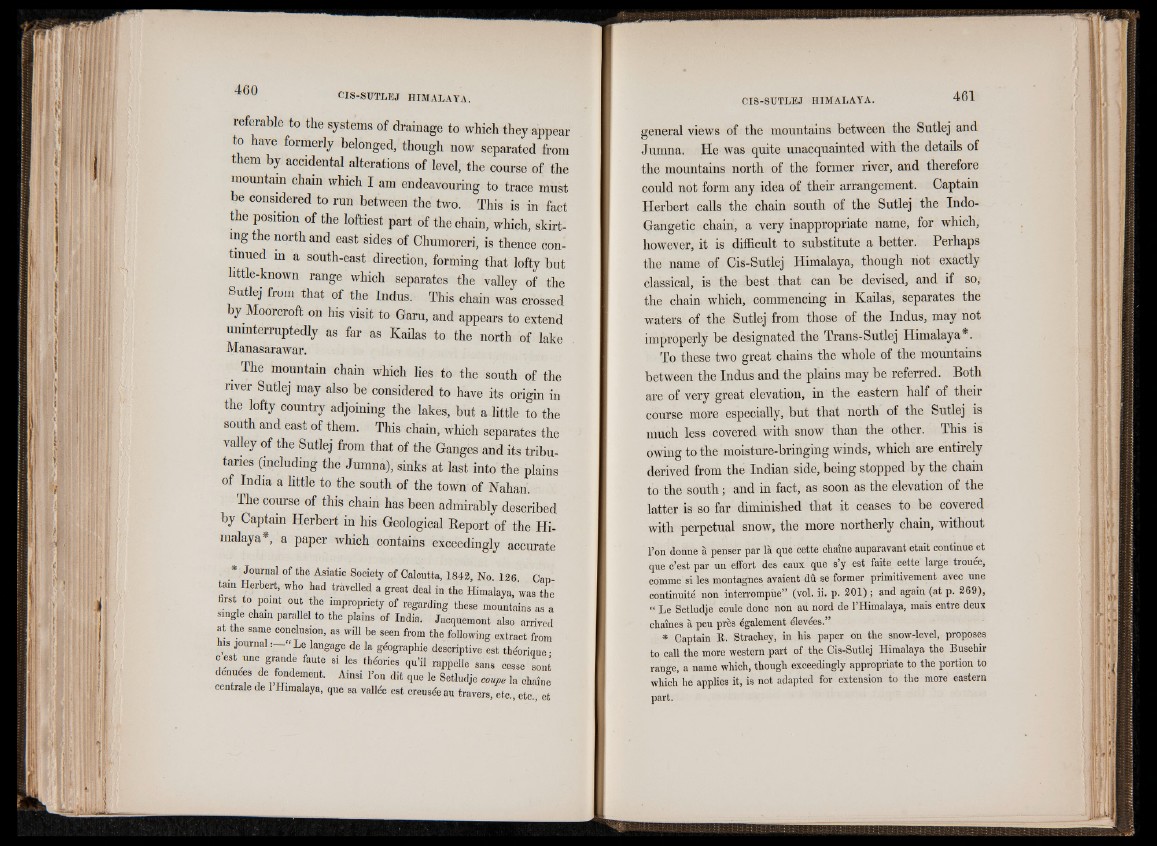
referable to the systems of drainage to which they appear
to have formerly belonged, though now separated from
them by accidental alterations of level, the course of the
mountain chain which I am endeavouring to trace must
be considered to run between the two. This is in fact
the position of the loftiest part of the chain, which, skirting
the north and east sides of Chumoreri, is thence continued
m a south-east direction, forming that lofty but
little-known range which separates the valley of the
Sutlej from that of the Indus. This chain was crossed
by Moorcroft on his visit to Garu, and appears to extend
uninterruptedly as far as Kailas to the north of lake
Manasarawar.
The mountain chain which lies to the south of the
river Sutlej may also be considered to have its origin in
the lofty country adjoining the lakes, but a little to the
south and east of them. This chain, which separates the
valley of the Sutlej from that of the Ganges and its tributaries
(including the Jumna), sinks at last into the plains
of India a little to the south of the town of Nahan.
The course of this chain has been admirably described
by Captain Herbert in his Geological Report of the Himalaya*,
a paper which contains exceedingly accurate
* Journal of the Asiatic Society of Calcutta, 1842, No. 126. Captain
Herbert, who had travelled a great deal in the Himalaya, was the
first to point out the impropriety of regarding these mountains as a
single chain parallel to the plains of India. Jacquemont also arrived
at the same conclusion, as will be seen from the following extract from
is journal « Le langage de la géographie descriptive est théorique •
c est une grande faute si les théories qu’il rappelle sans cesse I n i
denuees de fondement. Ainsi l’on dit que le Setludje coupe la chaîne
centrale de 1 Himalaya, que sa vallée est creusée au travers, etc., etc., et
general views of the mountains between the Sutlej and
Jumna. He was quite unacquainted with the details of
the mountains north of the former river, and therefore
could not form any idea of their arrangement. Captain
Herbert calls the chain south of the Sutlej the Indo-
Gangetic chain, a very inappropriate name, for which,
however, it is difficult to substitute a better. Perhaps
the name of Cis-Sutlej Himalaya, though not exactly
classical, is the best that can be devised, and if so,
the chain which, commencing in Kailas, separates the
waters of the Sutlej from those of the Indus, may not
improperly be designated the Trans-Sutlej Himalaya*.
To these two great chains the whole of the mountains
between the Indus and the plains may be referred. Both
are of very great elevation, in the eastern half of their
course more especially, but that north of the Sutlej is
much less covered with snow than the other. This is
owing to the moisture-bringing winds, which are entirely
derived from the Indian side, being stopped by the chain
to the south ; and in fact, as soon as the elevation of the
latter is so far diminished that it ceases to be covered
with perpetual snow, the more northerly chain, without
l’on donne à penser par là que cette chaîne auparavant était continue et
que c’est par uu effort des eaux que s’y est faite cette large trouee,
comme si les montagnes avaient dû se former primitivement avec une
continuité non interrompùe” (vol. ii. p. 201) ; and again (at p. 269),
“ Le Setludje coule donc non au nord de l’Himalaya, mais entre deux
chaînes à peu près également élevées.”
* Captain E. Strachey, in his paper on the snow-level, proposes
to call the more western part of the Cis-Sutlej Himalaya the Busehir
range, a name which, though exceedingly appropriate to the portion to
which he applies it, is not adapted for extension to the more eastern
part.